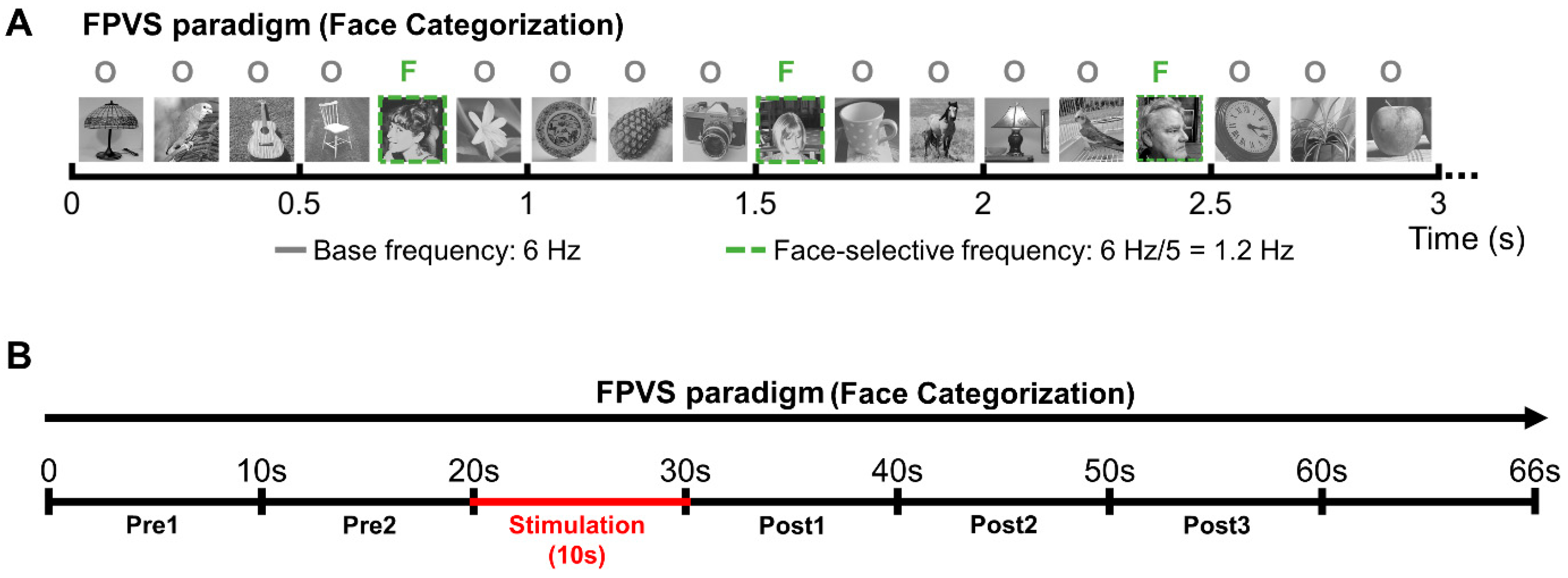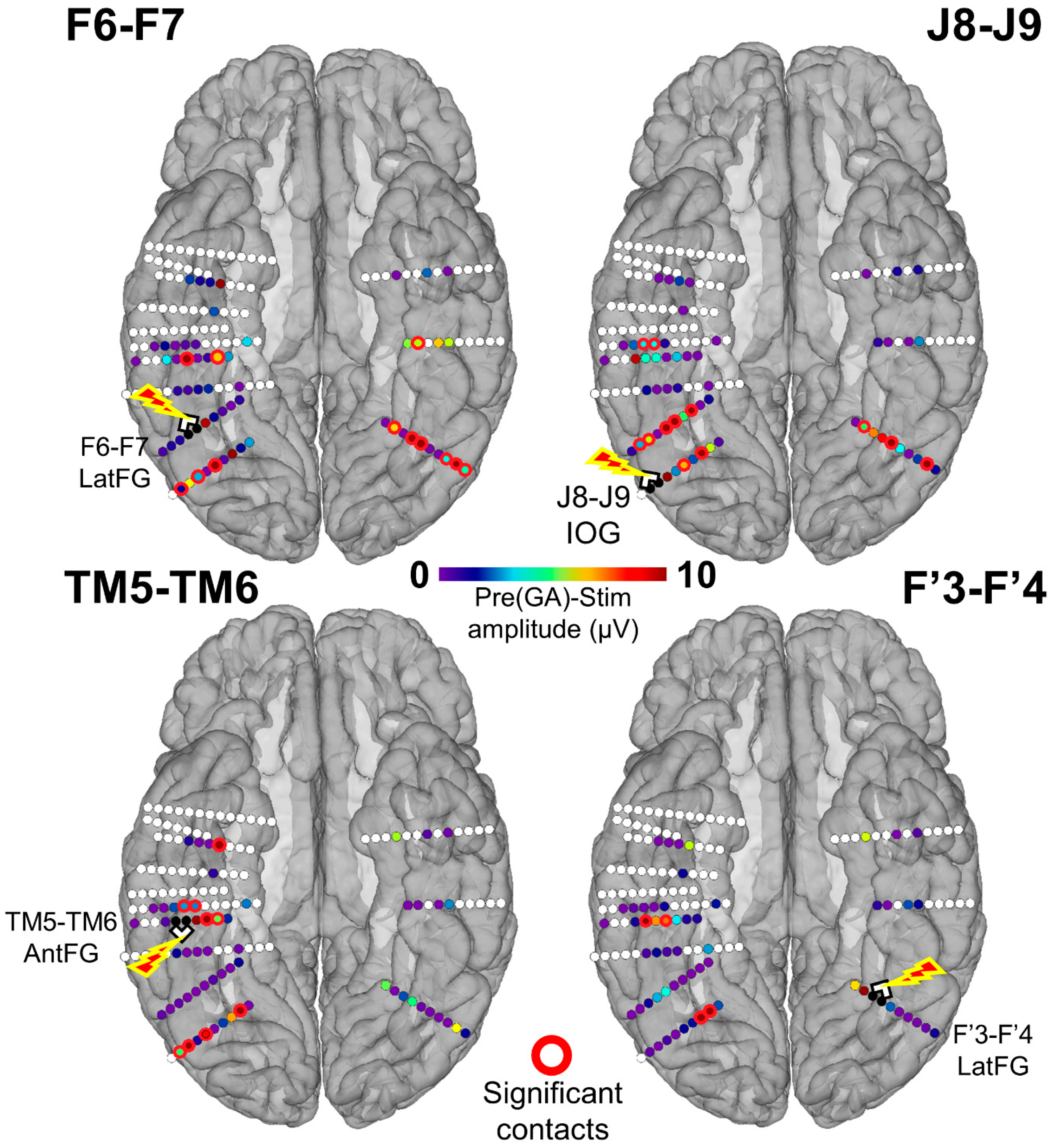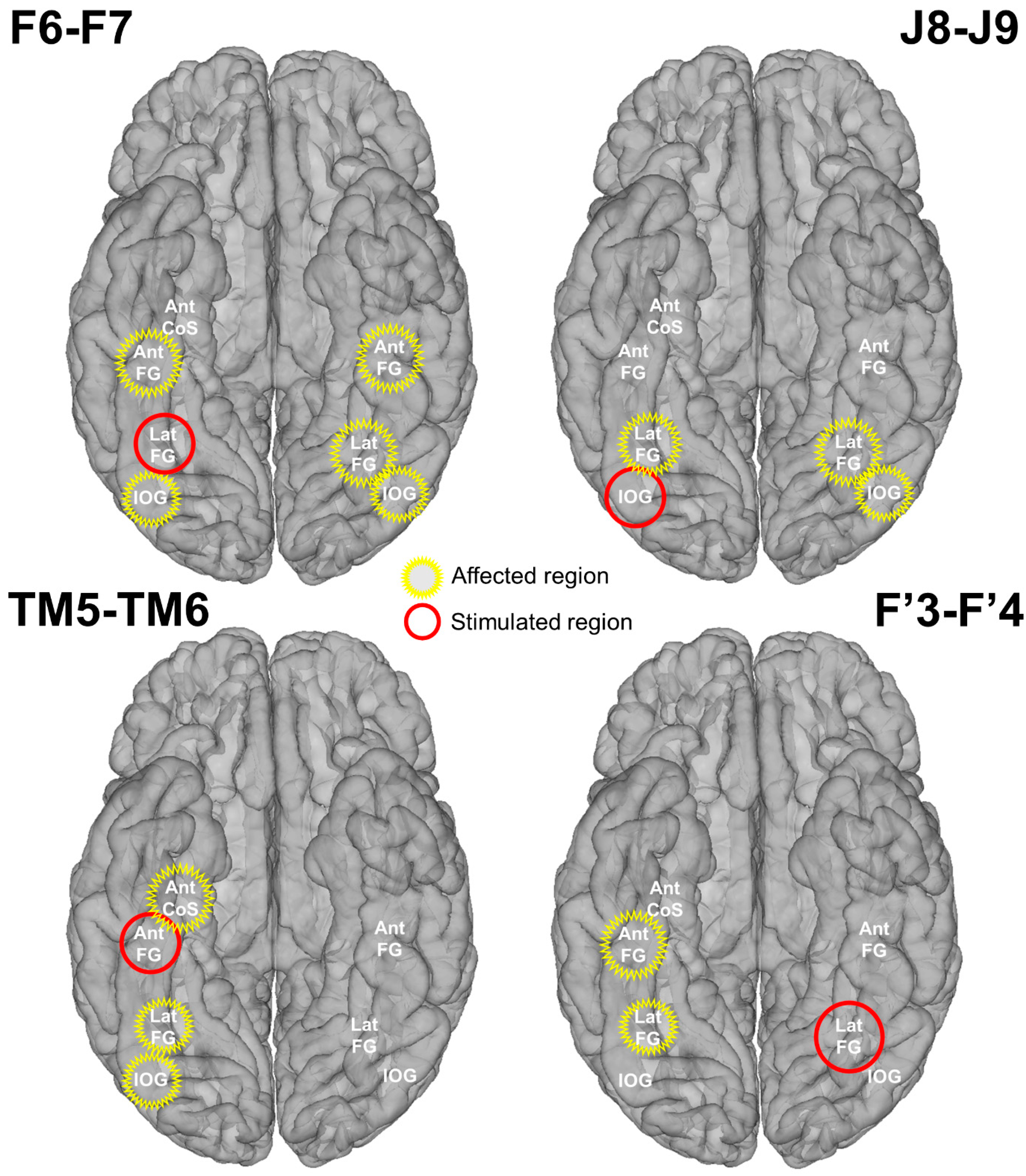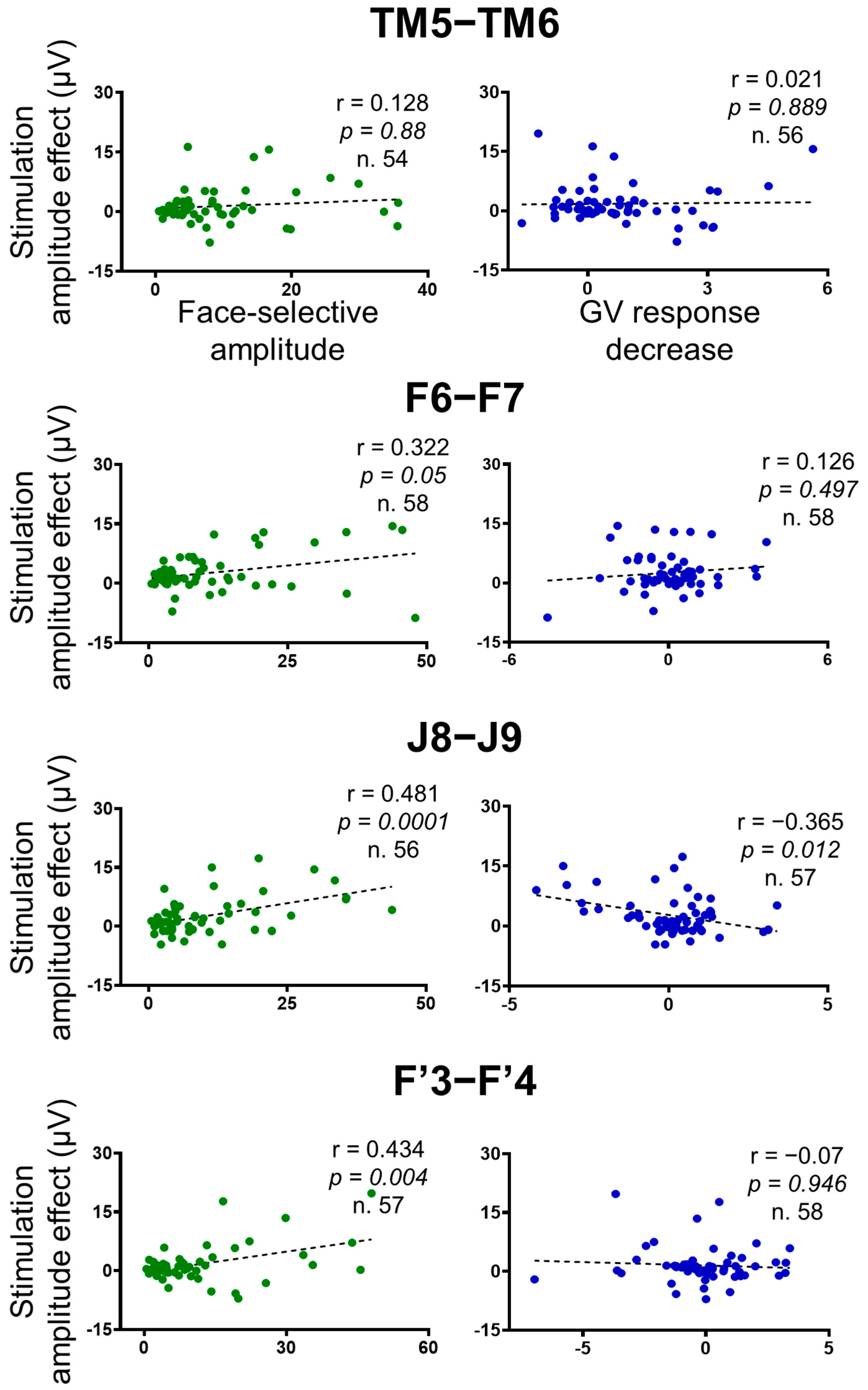Bidirectional and Cross-Hemispheric Modulations of Face-Selective Neural Activity Induced by Electrical Stimulation within the Human Cortical Face Network
Abstract
:1. Introduction
2. Materials and Methods
2.1. Case Description
2.2. Stereotactic Placement of Intracerebral Electrodes
2.3. Face-Selective Responses outside Electrical Stimulation
2.3.1. Stimuli and Procedure
2.3.2. Analysis of Intracerebral FPVS Responses
2.4. Intracerebral Electrical Stimulations during FPVS
2.4.1. Procedure
2.4.2. Analysis of Intracerebral FPVS Responses before, during and after Stimulation
2.4.3. Statistical Analyses
3. Results
3.1. Summary of the Experimental Plan
3.2. Stimulating Nodes of the Cortical Face Network Induces a Reduction of Face-Selective Neural Activity across the VOTC
3.3. Predominant Reduction of the Face-Selective Response Relative to Common Neural Activity to Faces and Objects
3.4. Functional Specificity of the Stimulation Effects
4. Discussion
4.1. Evidence for Bidirectional Effective Connectivity between IOG/OFA and LatFG/FFA
4.2. Effective Connectivity of Face-Selective Anterior Temporal Lobe Regions
4.3. Interhemispheric Effective Connectivity
Supplementary Materials
Author Contributions
Funding
Institutional Review Board Statement
Informed Consent Statement
Data Availability Statement
Conflicts of Interest
References
- Sergent, J.; Signoret, J.; Bruce, V.; Rolls, E.T.; Bruce, V.; Cowey, A.; Ellis, A.W.; Perrett, D.I. Functional and anatomical decomposition of face processing: Evidence from prosopagnosia and PET study of normal subjects. Philosophical Transactions of the Royal Society of London. Ser. B Biol. Sci. 1992, 335, 55–62. [Google Scholar] [CrossRef]
- Haxby, J.V.; Hoffman, E.A.; Gobbini, M.I. The distributed human neural system for face perception. Trends Cogn. Sci. 2000, 4, 223–233. [Google Scholar] [CrossRef] [PubMed]
- Calder, A.J.; Young, A.W. Understanding the recognition of facial identity and facial expression. Nat. Rev. Neurosci. 2005, 6, 641–651. [Google Scholar] [CrossRef] [PubMed]
- Grill-Spector, K.; Weiner, K.S.; Kay, K.; Gomez, J. The Functional Neuroanatomy of Human Face Perception. Annu. Rev. Vis. Sci. 2017, 3, 167–196. [Google Scholar] [CrossRef] [PubMed]
- Wang, Y.; Metoki, A.; Smith, D.V.; Medaglia, J.D.; Zang, Y.; Benear, S.; Popal, H.; Lin, Y.; Olson, I.R. Multimodal mapping of the face connectome. Nat. Hum. Behav. 2020, 4, 397–411. [Google Scholar] [CrossRef] [PubMed]
- Barton, J.J.S. Chapter 11—Face processing in the temporal lobe. In Handbook of Clinical Neurology; Miceli, G., Bartolomeo, P., Navarro, V., Eds.; Elsevier: Amsterdam, The Netherlands, 2022; Volume 187, pp. 191–210. [Google Scholar] [CrossRef]
- Gauthier, I.; Tarr, M.J.; Moylan, J.; Skudlarski, P.; Gore, J.C.; Anderson, A.W. The fusiform ‘face area’ is part of a network that processes faces at the individual level. J. Cogn. Neurosci. 2000, 12, 495–504. [Google Scholar] [CrossRef]
- Kanwisher, N.; McDermott, J.; Chun, M.M. The Fusiform Face Area: A Module in Human Extrastriate Cortex Specialized for Face Perception. J. Neurosci. 1997, 17, 4302–4311. [Google Scholar] [CrossRef]
- Jonas, J.; Jacques, C.; Liu-Shuang, J.; Brissart, H.; Colnat-Coulbois, S.; Maillard, L.; Rossion, B. A face-selective ventral occipito-temporal map of the human brain with intracerebral potentials. Proc. Natl. Acad. Sci. USA 2016, 113, E4088–E4097. [Google Scholar] [CrossRef]
- Weiner, K.S.; Grill-Spector, K. Sparsely-distributed organization of face and limb activations in human ventral temporal cortex. NeuroImage 2010, 52, 1559–1573. [Google Scholar] [CrossRef]
- Chen, X.; Liu, X.; Parker, B.J.; Zhen, Z.; Weiner, K.S. Functionally and structurally distinct fusiform face area(s) in over 1000 participants. NeuroImage 2023, 265, 119765. [Google Scholar] [CrossRef]
- Hoffman, E.A.; Haxby, J.V. Distinct representations of eye gaze and identity in the distributed human neural system for face perception. Nat. Neurosci. 2000, 3, 80–84. [Google Scholar] [CrossRef]
- Pitcher, D.; Duchaine, B.; Walsh, V. Combined TMS and fMRI Reveal Dissociable Cortical Pathways for Dynamic and Static Face Perception. Curr. Biol. 2014, 24, 2066–2070. [Google Scholar] [CrossRef]
- Rajimehr, R.; Young, J.C.; Tootell, R.B.H. An anterior temporal face patch in human cortex, predicted by macaque maps. Proc. Natl. Acad. Sci. USA 2009, 106, 1995–2000. [Google Scholar] [CrossRef] [PubMed]
- Von Der Heide, R.J.; Skipper, L.M.; Olson, I.R. Anterior temporal face patches: A meta-analysis and empirical study. Front. Hum. Neurosci. 2013, 7, 17. [Google Scholar] [CrossRef]
- Collins, J.A.; Koski, J.E.; Olson, I.R. More Than Meets the Eye: The Merging of Perceptual and Conceptual Knowledge in the Anterior Temporal Face Area. Front. Hum. Neurosci. 2016, 10, 189. [Google Scholar] [CrossRef] [PubMed]
- Allen, E.J.; St-Yves, G.; Wu, Y.; Breedlove, J.L.; Prince, J.S.; Dowdle, L.T.; Nau, M.; Caron, B.; Pestilli, F.; Charest, I.; et al. A massive 7T fMRI dataset to bridge cognitive neuroscience and artificial intelligence. Nat. Neurosci. 2022, 25, 116–126. [Google Scholar] [CrossRef] [PubMed]
- Allison, T.; Puce, A.; Spencer, D.D.; McCarthy, G. Electrophysiological Studies of Human Face Perception. I: Potentials Generated in Occipitotemporal Cortex by Face and Non-face Stimuli. Cereb. Cortex 1999, 9, 415–430. [Google Scholar] [CrossRef]
- Fairhall, S.L.; Ishai, A. Effective Connectivity within the Distributed Cortical Network for Face Perception. Cereb. Cortex 2007, 17, 2400–2406. [Google Scholar] [CrossRef]
- Gschwind, M.; Pourtois, G.; Schwartz, S.; Van De Ville, D.; Vuilleumier, P. White-Matter Connectivity between Face-Responsive Regions in the Human Brain. Cereb. Cortex 2012, 22, 1564–1576. [Google Scholar] [CrossRef]
- Ewbank, M.P.; Henson, R.N.; Rowe, J.B.; Stoyanova, R.S.; Calder, A.J. Different Neural Mechanisms within Occipitotemporal Cortex Underlie Repetition Suppression across Same and Different-Size Faces. Cereb. Cortex 2013, 23, 1073–1084. [Google Scholar] [CrossRef]
- Pyles, J.A.; Verstynen, T.D.; Schneider, W.; Tarr, M.J. Explicating the Face Perception Network with White Matter Connectivity. PLoS ONE 2013, 8, e61611. [Google Scholar] [CrossRef] [PubMed]
- Furl, N. Structural and effective connectivity reveals potential network-based influences on category-sensitive visual areas. Front. Hum. Neurosci. 2015, 9, 253. [Google Scholar] [CrossRef]
- Finzi, D.; Gomez, J.; Nordt, M.; Rezai, A.A.; Poltoratski, S.; Grill-Spector, K. Differential spatial computations in ventral and lateral face-selective regions are scaffolded by structural connections. Nat. Commun. 2021, 12, 2278. [Google Scholar] [CrossRef]
- Weiner, K.S.; Jonas, J.; Gomez, J.; Maillard, L.; Brissart, H.; Hossu, G.; Jacques, C.; Loftus, D.; Colnat-Coulbois, S.; Stigliani, A.; et al. The Face-Processing Network Is Resilient to Focal Resection of Human Visual Cortex. J. Neurosci. 2016, 36, 8425–8440. [Google Scholar] [CrossRef] [PubMed]
- Cohen, A.L.; Soussand, L.; Corrow, S.L.; Martinaud, O.; Barton, J.J.S.; Fox, M.D. Looking beyond the face area: Lesion network mapping of prosopagnosia. Brain 2019, 142, 3975–3990. [Google Scholar] [CrossRef]
- Kessler, R.; Rusch, K.M.; Wende, K.C.; Schuster, V.; Jansen, A. Revisiting the effective connectivity within the distributed cortical network for face perception. Neuroimage Rep. 2021, 1, 100045. [Google Scholar] [CrossRef]
- Duchaine, B.; Yovel, G. A Revised Neural Framework for Face Processing. Annu. Rev. Vis. Sci. 2015, 1, 393–416. [Google Scholar] [CrossRef]
- Bernstein, M.; Erez, Y.; Blank, I.; Yovel, G. An Integrated Neural Framework for Dynamic and Static Face Processing. Sci. Rep. 2018, 8, 7036. [Google Scholar] [CrossRef]
- Riesenhuber, M.; Poggio, T. Hierarchical models of object recognition in cortex. Nat. Neurosci. 1999, 2, 1019–1025. [Google Scholar] [CrossRef]
- Rust, N.C.; DiCarlo, J.J. Selectivity and Tolerance (“Invariance”) Both Increase as Visual Information Propagates from Cortical Area V4 to IT. J. Neurosci. 2010, 30, 12978–12995. [Google Scholar] [CrossRef]
- Ishai, A. Let’s face it: It’s a cortical network. NeuroImage 2008, 40, 415–419. [Google Scholar] [CrossRef]
- Pitcher, D.; Walsh, V.; Duchaine, B. The role of the occipital face area in the cortical face perception network. Exp. Brain Res. 2011, 209, 481–493. [Google Scholar] [CrossRef] [PubMed]
- Rolls, E.T. Neurophysiological mechanisms underlying face processing within and beyond the temporal cortical visual areas. Philos. Trans. R. Soc. London. Ser. B Biol. Sci. 1992, 335, 11–20. [Google Scholar] [CrossRef]
- Moeller, S.; Freiwald, W.A.; Tsao, D.Y. Patches with links: A unified system for processing faces in the macaque temporal lobe. Science 2008, 320, 1355–1359. [Google Scholar] [CrossRef]
- Freiwald, W.A.; Tsao, D.Y. Functional Compartmentalization and Viewpoint Generalization Within the Macaque Face-Processing System. Science 2010, 330, 845–851. [Google Scholar] [CrossRef]
- Rossion, B.; Caldara, R.; Seghier, M.; Schuller, A.; Lazeyras, F.; Mayer, E. A network of occipito-temporal face-sensitive areas besides the right middle fusiform gyrus is necessary for normal face processing. Brain 2003, 126, 2381–2395. [Google Scholar] [CrossRef]
- Steeves, J.K.E.; Culham, J.C.; Duchaine, B.C.; Pratesi, C.C.; Valyear, K.F.; Schindler, I.; Humphrey, G.K.; Milner, A.D.; Goodale, M.A. The fusiform face area is not sufficient for face recognition: Evidence from a patient with dense prosopagnosia and no occipital face area. Neuropsychologia 2006, 44, 594–609. [Google Scholar] [CrossRef] [PubMed]
- Frässle, S.; Paulus, F.M.; Krach, S.; Schweinberger, S.R.; Stephan, K.E.; Jansen, A. Mechanisms of hemispheric lateralization: Asymmetric interhemispheric recruitment in the face perception network. NeuroImage 2016, 124, 977–988. [Google Scholar] [CrossRef]
- Rossion, B.; Jacques, C.; Jonas, J. The anterior fusiform gyrus: The ghost in the cortical face machine. Neurosci. Biobehav. Rev. 2024, 158, 105535. [Google Scholar] [CrossRef]
- Jacques, C.; Jonas, J.; Colnat-Coulbois, S.; Maillard, L.; Rossion, B. Low and high frequency intracranial neural signals match in the human associative cortex. eLife 2022, 11, e76544. [Google Scholar] [CrossRef]
- Kuskowski, M.A.; Pardo, J.V. The role of the fusiform gyrus in successful encoding of face stimuli. NeuroImage 1999, 9, 599–610. [Google Scholar] [CrossRef] [PubMed]
- Wiser, A.K.; Andreasen, N.C.; O’Leary, D.S.; Crespo-Facorro, B.; Boles-Ponto, L.L.; Watkins, G.L.; Hichwa, R.D. Novel vs. Well-learned Memory for Faces: A Positron Emission Tomography Study. J. Cogn. Neurosci. 2000, 12, 255–266. [Google Scholar] [CrossRef] [PubMed]
- Rossion, B.; Schiltz, C.; Robaye, L.; Pirenne, D.; Crommelinck, M. How Does the Brain Discriminate Familiar and Unfamiliar Faces?: A PET Study of Face Categorical Perception. J. Cogn. Neurosci. 2001, 13, 1019–1034. [Google Scholar] [CrossRef]
- Barton, J.J. Structure and function in acquired prosopagnosia: Lessons from a series of 10 patients with brain damage. J. Neuropsychol. 2008, 2, 197–225. [Google Scholar] [CrossRef] [PubMed]
- Jonas, J.; Rossion, B.; Brissart, H.; Frismand, S.; Jacques, C.; Hossu, G.; Colnat-Coulbois, S.; Vespignani, H.; Vignal, J.-P.; Maillard, L. Beyond the core face-processing network: Intracerebral stimulation of a face-selective area in the right anterior fusiform gyrus elicits transient prosopagnosia. Cortex 2015, 72, 140–155. [Google Scholar] [CrossRef]
- Volfart, A.; Yan, X.; Maillard, L.; Colnat-Coulbois, S.; Hossu, G.; Rossion, B.; Jonas, J. Intracerebral electrical stimulation of the right anterior fusiform gyrus impairs human face identity recognition. NeuroImage 2022, 250, 118932. [Google Scholar] [CrossRef]
- Penfield, W. The excitable cortex in conscious man. In The Sherrington Lectures V; Thomas, C.C., Ed.; Charles C. Thomas: Springfield, IL, USA, 1958; pp. pp. 7–11, 16, 18–20. [Google Scholar]
- Borchers, S.; Himmelbach, M.; Logothetis, N.; Karnath, H.-O. Direct electrical stimulation of human cortex—The gold standard for mapping brain functions? Nature Reviews. Neuroscience 2012, 13, 63–70. [Google Scholar] [CrossRef]
- Mahon, B.Z.; Miozzo, M.; Pilcher, W.H. Direct electrical stimulation mapping of cognitive functions in the human brain. Cogn. Neuropsychol. 2019, 36, 97–102. [Google Scholar] [CrossRef]
- Jonas, J.; Rossion, B. What Are the Contributions and Challenges of Direct Intracranial Electrical Stimulation in Human Cognitive Neuroscience? In Intracranial EEG: A Guide for Cognitive Neuroscientists; Axmacher, N., Ed.; Springer International Publishing: Berlin/Heidelberg, Germany, 2023; pp. 607–638. [Google Scholar] [CrossRef]
- Angelini, L.; Volfart, A.; Jacques, C.; Colnat-Coulbois, S.; Maillard, L.; Rossion, B.; Jonas, J. Effective connectivity of functional brain regions through concurrent intracerebral electrical stimulation and frequency-tagged visual presentation. Brain Stimul. Basic Transl. Clin. Res. Neuromodul. 2024, 17, 726–729. [Google Scholar] [CrossRef]
- Rossion, B.; Michel, C. Normative accuracy and response time data for the computerized Benton Facial Recognition Test (BFRT-c). Behav. Res. Methods 2018, 50, 2442–2460. [Google Scholar] [CrossRef]
- Busigny, T.; Rossion, B. Acquired prosopagnosia abolishes the face inversion effect. Cortex 2020, 46, 965–981. [Google Scholar] [CrossRef]
- Crawford, J.R.; Howell, D.C. Comparing an Individual’s Test Score Against Norms Derived from Small Samples. Clin. Neuropsychol. 1998, 12, 482–486. [Google Scholar] [CrossRef]
- Volfart, A.; Jonas, J.; Maillard, L.; Busigny, T.; Rossion, B.; Brissart, H. Typical visual unfamiliar face individuation in left and right mesial temporal epilepsy. Neuropsychologia 2020, 147, 107583. [Google Scholar] [CrossRef]
- Talairach, J.; Bancaud, J. Stereotaxic Approach to Epilepsy. In Progress in Neurological Surgery; Krayenbühl, H., Maspes, P.E., Sweet, W.H., Eds.; S. Karger AG: Basel, Switzerland, 1973; Volume 5, pp. 297–354. [Google Scholar] [CrossRef]
- Rossion, B.; Torfs, K.; Jacques, C.; Liu-Shuang, J. Fast periodic presentation of natural images reveals a robust face-selective electrophysiological response in the human brain. J. Vis. 2015, 15, 18. [Google Scholar] [CrossRef] [PubMed]
- Rossion, B.; Jacques, C.; Jonas, J. Intracerebral Electrophysiological Recordings to Understand the Neural Basis of Human Face Recognition. Brain Sci. 2023, 13, 2. [Google Scholar] [CrossRef] [PubMed]
- Lochy, A.; Jacques, C.; Maillard, L.; Colnat-Coulbois, S.; Rossion, B.; Jonas, J. Selective visual representation of letters and words in the left ventral occipito-temporal cortex with intracerebral recordings. Proc. Natl. Acad. Sci. USA 2018, 115, E7595–E7604. [Google Scholar] [CrossRef]
- Jacques, C.; Rossion, B.; Volfart, A.; Brissart, H.; Colnat-Coulbois, S.; Maillard, L.; Jonas, J. The neural basis of rapid unfamiliar face individuation with human intracerebral recordings. NeuroImage 2020, 221, 117174. [Google Scholar] [CrossRef]
- Trébuchon, A.; Chauvel, P. Electrical Stimulation for Seizure Induction and Functional Mapping in Stereoelectroencephalography. J. Clin. Neurophysiol. 2016, 33, 511. [Google Scholar] [CrossRef]
- Isnard, J.; Taussig, D.; Bartolomei, F.; Bourdillon, P.; Catenoix, H.; Chassoux, F.; Chipaux, M.; Clémenceau, S.; Colnat-Coulbois, S.; Denuelle, M.; et al. French guidelines on stereoelectroencephalography (SEEG). Neurophysiol. Clin. 2018, 48, 5–13. [Google Scholar] [CrossRef]
- Ritaccio, A.L.; Brunner, P.; Schalk, G. ELECTRICAL STIMULATION MAPPING of the Brain: Basic Principles and Emerging Alternatives. J. Clin. Neurophysiol. Off. Publ. Am. Electroencephalogr. Soc. 2018, 35, 86–97. [Google Scholar] [CrossRef]
- So, E.L.; Alwaki, A. A Guide for Cortical Electrical Stimulation Mapping. J. Clin. Neurophysiol. 2018, 35, 98–105. [Google Scholar] [CrossRef]
- Grande, K.M.; Ihnen, S.K.Z.; Arya, R. Electrical Stimulation Mapping of Brain Function: A Comparison of Subdural Electrodes and Stereo-EEG. Front. Hum. Neurosci. 2020, 14, 611291. [Google Scholar] [CrossRef]
- Benjamini, Y.; Hochberg, Y. Controlling the False Discovery Rate: A Practical and Powerful Approach to Multiple Testing. J. R. Stat. Soc. Ser. B (Methodol.) 1995, 57, 289–300. [Google Scholar] [CrossRef]
- Norcia, A.M.; Appelbaum, L.G.; Ales, J.M.; Cottereau, B.R.; Rossion, B. The steady-state visual evoked potential in vision research: A review. J. Vis. 2015, 15, 4. [Google Scholar] [CrossRef]
- Rossion, B.; Retter, T.L.; Liu-Shuang, J. Understanding human individuation of unfamiliar faces with oddball fast periodic visual stimulation and electroencephalography. Eur. J. Neurosci. 2020, 52, 4283–4344. [Google Scholar] [CrossRef] [PubMed]
- Powell, H.W.R.; Richardson, M.P.; Symms, M.R.; Boulby, P.A.; Thompson, P.J.; Duncan, J.S.; Koepp, M.J. Reorganization of Verbal and Nonverbal Memory in Temporal Lobe Epilepsy Due to Unilateral Hippocampal Sclerosis. Epilepsia 2007, 48, 1512–1525. [Google Scholar] [CrossRef]
- Sidhu, M.K.; Stretton, J.; Winston, G.P.; Bonelli, S.; Centeno, M.; Vollmar, C.; Symms, M.; Thompson, P.J.; Koepp, M.J.; Duncan, J.S. A functional magnetic resonance imaging study mapping the episodic memory encoding network in temporal lobe epilepsy. Brain 2013, 136, 1868–1888. [Google Scholar] [CrossRef]
- Fleury, M.; Buck, S.; Binding, L.P.; Caciagli, L.; Vos, S.B.; Winston, G.P.; Thompson, P.J.; Koepp, M.J.; Duncan, J.S.; Sidhu, M.K. Episodic memory network connectivity in temporal lobe epilepsy. Epilepsia 2022, 63, 2597–2622. [Google Scholar] [CrossRef] [PubMed]
- Wirsich, J.; Iannotti, G.R.; Ridley, B.; Shamshiri, E.A.; Sheybani, L.; Grouiller, F.; Bartolomei, F.; Seeck, M.; Lazeyras, F.; Ranjeva, J.-P.; et al. Altered correlation of concurrently recorded EEG-fMRI connectomes in temporal lobe epilepsy. Netw. Neurosci. 2024, 8, 466–485. [Google Scholar] [CrossRef]
- Gobbini, M.I.; Haxby, J.V. Neural systems for recognition of familiar faces. Neuropsychologia 2007, 45, 32–41. [Google Scholar] [CrossRef]
- Sadeh, B.; Podlipsky, I.; Zhdanov, A.; Yovel, G. Event-related potential and functional MRI measures of face-selectivity are highly correlated: A simultaneous ERP-fMRI investigation. Hum. Brain Mapp. 2010, 31, 1490–1501. [Google Scholar] [CrossRef]
- Jiang, F.; Dricot, L.; Weber, J.; Righi, G.; Tarr, M.J.; Goebel, R.; Rossion, B. Face categorization in visual scenes may start in a higher order area of the right fusiform gyrus: Evidence from dynamic visual stimulation in neuroimaging. J. Neurophysiol. 2011, 106, 2720–2736. [Google Scholar] [CrossRef] [PubMed]
- Kadipasaoglu, C.M.; Conner, C.R.; Baboyan, V.G.; Rollo, M.; Pieters, T.A.; Tandon, N. Network dynamics of human face perception. PLoS ONE 2017, 12, e0188834. [Google Scholar] [CrossRef]
- Rossion, B. Constraining the cortical face network by neuroimaging studies of acquired prosopagnosia. NeuroImage 2008, 40, 423–426. [Google Scholar] [CrossRef]
- Rossion, B. Twenty years of investigation with the case of prosopagnosia PS to understand human face identity recognition. Part II: Neural basis. Neuropsychologia 2022, 173, 108279. [Google Scholar] [CrossRef]
- Felleman, D.J.; Van Essen, D.C. Distributed Hierarchical Processing in the Primate Cerebral Cortex. Cereb. Cortex 1991, 1, 1–47. [Google Scholar] [CrossRef] [PubMed]
- Gamberini, M.; Passarelli, L.; Fattori, P.; Zucchelli, M.; Bakola, S.; Luppino, G.; Galletti, C. Cortical connections of the visuomotor parietooccipital area V6Ad of the macaque monkey. J. Comp. Neurol. 2009, 513, 622–642. [Google Scholar] [CrossRef] [PubMed]
- Edelman, G.M.; Gally, J.A. Reentry: A key mechanism for integration of brain function. Front. Integr. Neurosci. 2013, 7, 63. [Google Scholar] [CrossRef]
- Markov, N.T.; Ercsey-Ravasz, M.M.; Ribeiro Gomes, A.R.; Lamy, C.; Magrou, L.; Vezoli, J.; Misery, P.; Falchier, A.; Quilodran, R.; Gariel, M.A.; et al. A Weighted and Directed Interareal Connectivity Matrix for Macaque Cerebral Cortex. Cereb. Cortex 2014, 24, 17–36. [Google Scholar] [CrossRef]
- Schiltz, C.; Sorger, B.; Caldara, R.; Ahmed, F.; Mayer, E.; Goebel, R.; Rossion, B. Impaired Face Discrimination in Acquired Prosopagnosia Is Associated with Abnormal Response to Individual Faces in the Right Middle Fusiform Gyrus. Cereb. Cortex 2006, 16, 574–586. [Google Scholar] [CrossRef]
- Jonas, J.; Descoins, M.; Koessler, L.; Colnat-Coulbois, S.; Sauvée, M.; Guye, M.; Vignal, J.-P.; Vespignani, H.; Rossion, B.; Maillard, L. Focal electrical intracerebral stimulation of a face-sensitive area causes transient prosopagnosia. Neuroscience 2012, 222, 281–288. [Google Scholar] [CrossRef] [PubMed]
- Volfart, A.; Rossion, B.; Yan, X.; Angelini, L.; Maillard, L.; Colnat-Coulbois, S.; Jonas, J. Intracerebral electrical stimulation of the face-selective right lateral fusiform gyrus transiently impairs face identity recognition. Neuropsychologia 2023, 190, 108705. [Google Scholar] [CrossRef] [PubMed]
- Ojemann, J.G.; Akbudak, E.; Snyder, A.Z.; McKinstry, R.C.; Raichle, M.E.; Conturo, T.E. Anatomic Localization and Quantitative Analysis of Gradient Refocused Echo-Planar fMRI Susceptibility Artifacts. NeuroImage 1997, 6, 156–167. [Google Scholar] [CrossRef] [PubMed]
- Visser, M.; Jefferies, E.; Lambon Ralph, M.A. Semantic Processing in the Anterior Temporal Lobes: A Meta-analysis of the Functional Neuroimaging Literature. J. Cogn. Neurosci. 2010, 22, 1083–1094. [Google Scholar] [CrossRef]
- Wandell, B.A. The neurobiological basis of seeing words. Ann. N. Y. Acad. Sci. 2011, 1224, 63–80. [Google Scholar] [CrossRef]
- Axelrod, V.; Yovel, G. Hierarchical Processing of Face Viewpoint in Human Visual Cortex. J. Neurosci. 2012, 32, 2442–2452. [Google Scholar] [CrossRef]
- Rice, G.E.; Hoffman, P.; Binney, R.J.; Lambon Ralph, M.A. Concrete versus abstract forms of social concept: An fMRI comparison of knowledge about people versus social terms. Philos. Trans. R. Soc. B Biol. Sci. 2018, 373, 20170136. [Google Scholar] [CrossRef]
- Persichetti, A.S.; Denning, J.M.; Gotts, S.J.; Martin, A. A Data-Driven Functional Mapping of the Anterior Temporal Lobes. J. Neurosci. 2021, 41, 6038–6049. [Google Scholar] [CrossRef] [PubMed]
- Rossion, B.; Taubert, J. What can we learn about human individual face recognition from experimental studies in monkeys? Vis. Res. 2019, 157, 142–158. [Google Scholar] [CrossRef]
- Rossion, B. What makes us human? Face Identity Recognition. In The Routledge Handbook of Semiosis and the Brain; Garcia, A., Ibanez, A., Eds.; Routledge: Oxfordshire, UK, 2022; Chapter 21; pp. 325–345. [Google Scholar]
- Grimaldi, P.; Saleem, K.S.; Tsao, D. Anatomical Connections of the Functionally Defined “Face Patches” in the Macaque Monkey. Neuron 2016, 90, 1325–1342. [Google Scholar] [CrossRef]
- Zhu, Q.; Zhang, J.; Luo, Y.L.L.; Dilks, D.D.; Liu, J. Resting-State Neural Activity across Face-Selective Cortical Regions Is Behaviorally Relevant. J. Neurosci. 2011, 31, 10323–10330. [Google Scholar] [CrossRef] [PubMed]
- Davies-Thompson, J.; Andrews, T.J. Intra- and interhemispheric connectivity between face-selective regions in the human brain. J. Neurophysiol. 2012, 108, 3087–3095. [Google Scholar] [CrossRef] [PubMed]
- Quinn, B.P.A.; Watson, D.M.; Noad, K.; Andrews, T.J. Idiosyncratic patterns of interhemispheric connectivity in the face and scene networks of the human brain. Imaging Neurosci. 2024, 2, 1–20. [Google Scholar] [CrossRef]







Disclaimer/Publisher’s Note: The statements, opinions and data contained in all publications are solely those of the individual author(s) and contributor(s) and not of MDPI and/or the editor(s). MDPI and/or the editor(s) disclaim responsibility for any injury to people or property resulting from any ideas, methods, instructions or products referred to in the content. |
© 2024 by the authors. Licensee MDPI, Basel, Switzerland. This article is an open access article distributed under the terms and conditions of the Creative Commons Attribution (CC BY) license (https://creativecommons.org/licenses/by/4.0/).
Share and Cite
Angelini, L.; Jacques, C.; Maillard, L.; Colnat-Coulbois, S.; Rossion, B.; Jonas, J. Bidirectional and Cross-Hemispheric Modulations of Face-Selective Neural Activity Induced by Electrical Stimulation within the Human Cortical Face Network. Brain Sci. 2024, 14, 906. https://doi.org/10.3390/brainsci14090906
Angelini L, Jacques C, Maillard L, Colnat-Coulbois S, Rossion B, Jonas J. Bidirectional and Cross-Hemispheric Modulations of Face-Selective Neural Activity Induced by Electrical Stimulation within the Human Cortical Face Network. Brain Sciences. 2024; 14(9):906. https://doi.org/10.3390/brainsci14090906
Chicago/Turabian StyleAngelini, Luna, Corentin Jacques, Louis Maillard, Sophie Colnat-Coulbois, Bruno Rossion, and Jacques Jonas. 2024. "Bidirectional and Cross-Hemispheric Modulations of Face-Selective Neural Activity Induced by Electrical Stimulation within the Human Cortical Face Network" Brain Sciences 14, no. 9: 906. https://doi.org/10.3390/brainsci14090906





